11 Best first-time Europe itineraries for 1, 2, or 3 weeks
Europe is going to be very busy in the summer of 2024 as the world is back to normal and travel demand is higher than ever. One other key factor is that most European currencies are still hovering at lower levels historically compared to the US dollar, which means that Europe will feel somewhat cheap again this year. In fact, according to our World Backpacker Index, European cities like Lisbon, Madrid, and Munich are about 30% cheaper to visit than Boston, Chicago, and New York City. In other words, flying to Europe might seem expensive, but most things will be cheaper once you get there compared to the costs of visiting a large US city.
Below you’ll find 11 of the most popular and best itineraries for a first visit to Europe. Your first visit is not really the time to be different or creative, and the famous destinations tend to be popular for a reason. In other words, it’s kind of silly to visit, say, Bulgaria, if you’ve not yet been to France or Italy. I lay out the best options along with how long to stay in each place as a general guide. I also discuss Mediterranean cruises, which can actually be an amazing way to see a lot of Europe on your first visit, especially if you don’t like going back and forth to train stations and airports every 2 or 3 days.
For a bit of fun you might be interested in the cheapest 5-star hotels in Europe, which start at US$80 per night for really nice hotels. It helps show that if you choose some of the cheaper cities, you can treat yourself to some luxury that you can’t afford in most other places.
This article was last updated in March, 2024.
There are 11 starter itineraries described in detail below
- Classic London and Paris
- England and Scotland
- Paris and Italy
- Mediterranean cruise
- France, Belgium, and Netherlands
- Paris and elsewhere in France
- Italy
- Spain
- Germany
- Switzerland
- Best of cheap eastern Europe
For each itinerary there are suggestions of other destinations that are easy to add on to the main cities.
Note: This article was most recently updated in March, 2024
Building the best itinerary for your first trip to Europe
Below there are 11 popular itineraries for one week in Europe. If you’ve only got a week then choose one of them and assume you’ll return again to conquer more of this amazing part of the world. If you’ve got more time then you can choose from some of the top add-on suggestions for each one.
Start in the most famous cities
Your first visit to Europe is no time to try to be different or edgy. I recommend that you focus on these 5 great cities before you start branching out into cheaper or more obscure places.
Keep your travel days to a minimum
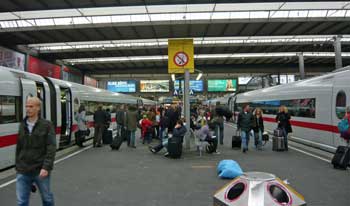
Spend 3 (or 4) nights in almost every major city
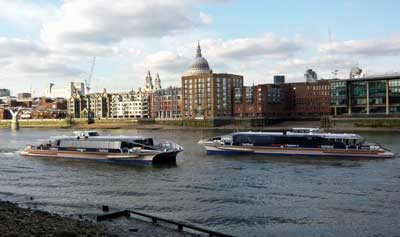
So many first-time visitors are initially planning on spending only 1 or 2 nights in major cities that I wrote a detailed explanation of why 3 nights is ideal for almost all European cities, even if you want to see as much as possible.
3 (or 4) nights will be enough for any city on your first trip
Most first-time visitors are tempted to move too quickly, but it can also be a mistake to move too slowly. It’s really amazing how much you can see in two full sightseeing days. If you spend too long in one city you’ll end up seeing things that are way down your list, while you could be in another city seeing things at the top of your list there.
Choose cities that are easy to reach from each other
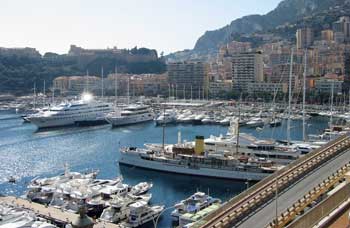
For your first trip it’s best to visit cities that are no more than a 5-hour train ride apart.
Choose cities that are connected by reasonable train rides rather than flights
To build on the point above, finding cheap flights within Europe is easy, but train travel is about a million times more enjoyable and less stressful. You’ll enjoy the train rides almost as much as the cities, so focus on places that are within 5 hours of each other by train.
Start with one of the classic itineraries below, and then add to it if you have more time
If you only have 7 days then you’ll find a list below of classic itineraries that are well-suited to a first visit to Europe. Hopefully you have more than 7 days though, and if you do you can add in one or more of the suggested add-on cities to build an itinerary that appeals most to you.
Best 1-week itineraries for the first time in Europe
Itinerary 1: Classic London and Paris
Fly into either city and take the 2-hour Eurostar train between them
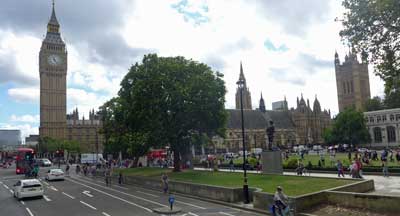
London highlights
- Big Ben and Parliament
- Westminster Abbey and St. Paul’s Cathedral
- Tower of London and Tower Bridge
- West End shows (Broadway equivalent) and classic pubs
- Buckingham Palace and Windsor Castle
Paris is actually far more beautiful than London and the food is famously much better as well. Since Paris gets so many tourists from non-French speaking countries, it’s easy to get by on just English, and the Metro system makes it fast and easy to get around. The architecture of both cities is amazing from the Tower of London, Big Ben, Westminster Abbey to the Louvre and the Eiffel Tower. These cities each pack a huge punch and they are very different from each other as well. Actually, England is arguably the best choice for your first trip to Europe.
Paris highlights
- Eiffel Tower
- Louvre Museum and Museum de Orsay
- Arc de Triomphe and other monuments
- Montmartre neighborhood and Sacré Coeur Cathedral
- Probably the world’s best affordable restaurants and wine
Best add-ons to London and Paris
- Edinburgh (2 or 3 nights, from London)
- Amsterdam (2 or 3 nights, from Paris)
- Bruges and Brussels (2 nights, from Paris)
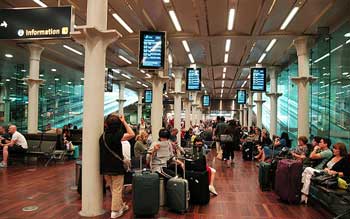
>>>Best one-week London and Paris itinerary in detail
>>>Check London hotel deals
>>>Check Paris hotel deals
Itinerary 2: England and Scotland
- London (3 or 4 nights)
- York (1 night)
- Edinburgh, Scotland (2 or 3 nights)
- Inverness, Scotland (2 or 3 nights)
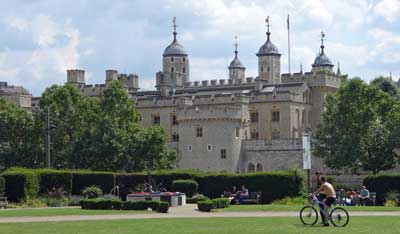
York is a small Roman city with intact city walls and one of the most famous cathedrals in Europe. Edinburgh is not only the capital of Scotland, but it’s easily the second most interesting city in all of Britain. If your time is short, skip York and spend more time in Edinburgh.
If you prefer to focus on the south of England on your first trip then the best option is to go to Bath or nearby Bristol after London. Bath is another of England’s top destinations and it’s a gorgeous city that has been a spa resort for many centuries. It’s also reasonably close to Stonehenge. You can also easily get to Cornwall in England’s southwest corner from Bath, and that’s a whole different and fascinating experience (with nicer weather than up north).
If you’ve got more than a week and want to spend more time in Scotland, especially in the summer months, the place to head to is Inverness. It’s a small town that is considered the gateway to the Scottish Highlands, but it’s an interesting and charming place on its own. You can take day-trips by bus to the highlights of the Highlands including the Isle of Skye and Loch Ness. Between you and me, it’s better to minimize time in Loch Ness or skip it altogether because it’s not one of the more photogenic parts of Scotland and the monster has always been a hoax.
Travel times between the recommended places
- London to York by train: 2 hours
- York to Edinburgh by train: 2.5 hours
- London to Edinburgh by train: 4 hours
- Edinburgh to Inverness by train: 3.5 hours
- London to Bath by train: 85 minutes
Best add-ons to England and Scotland
If you think you want to spend your whole trip in Britain you should have a look at our article on the best itineraries in England, Scotland, and Wales.
>>>Check London hotel deals
>>>Check Edinburgh hotel deals
Itinerary 3: Paris and Italy
- Paris (3 or 4 nights)
- Venice (1 night)
- Florence (2 or 3 nights)
- Rome (3 nights)
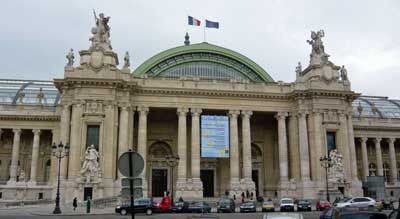
From Paris you can easily fly to Venice (or nearby Treviso) where you should try to spend about 24 hours. Venice is small enough to see in a full day, and so crowded that most people are satisfied to leave after that day. The key is to stay in the main part of the main island so you can enjoy Venice before the cruise passengers and day-trippers arrive, and also after they leave for the day. Two nights in Venice would not be wasted time, and it’s possibly the most gorgeous city in the entire world, but you can see the best of it in a bit over 24 hours.
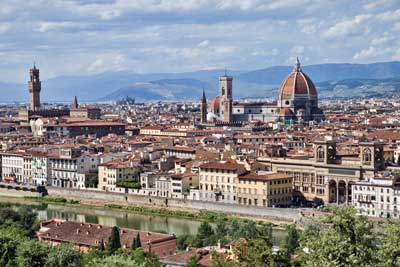
Rome also lives up to the hype and spending a day in the Vatican City will be a highlight even for non-Catholics, but it’s also a crowded and busy city so three days is usually enough for most people. Similar to Paris, Rome is an unusually beautiful city from almost any angle when you are in the historical center. You’ll walk through a stunning piazza (town square) and then turn a corner and you’ll see gorgeous buildings or public statues that are as nice as anything in the museums. Seriously, it’s worth a visit.
Paris to Venice flight: 1 hour 35 minutes
Venice to Florence by train: 1 hour 53 minutes
Florence to Rome by train: 1 hour 16 minutes
You can of course instead fly from Paris to Rome and then go north to Florence and then to Venice and fly home (or back to Paris) from there, and it would be just as enjoyable.
Best add-ons to Paris and Italy
France
- Nice/Cannes/Monaco (2 or 3 nights)
- Avignon (2 nights)
- Bourges (2 nights)
- Bordeaux (2 nights)
- Aix-en-Provence (2 nights)
- Reims (2 nights)
- Dijon/Burgundy (2 nights)
Italy
- Milan (1 or 2 nights)
- Lake Como (2 nights)
- Siena (2 nights)
- Cinque Terre (1 night)
- Naples/Sorrento/Amalfi Coast/Pompeii/Capri (3 to 5 nights)
- Sicily (3 to 4 nights)
>>>Much more information in this article about the best France and Italy itineraries
>>>Check Paris hotel deals
>>>Check Venice hotel deals
>>>Check Florence hotel deals
>>>Check Rome hotel deals
Itinerary 4: Mediterranean cruise
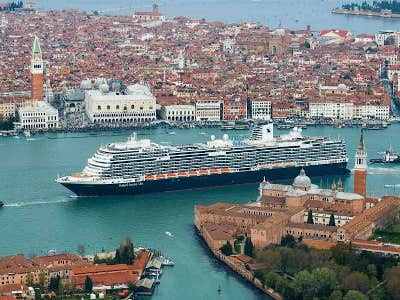
In spite of the reputation of cruises to be floating buffets, they can actually be an excellent way to visit a great number of amazing European cities in a short time. The ship typically is in port from the early morning until mid evening, often giving you the opportunity to have dinner in the city (unlike Caribbean cruises). Better still, the cruise ports are often near the center of town, so you can just walk off the ship and do sightseeing on foot or by public transportation.
Mediterranean cruises usually start at 7 nights but can go up to 3 weeks, which can provide an amazing tour of the entire region without having to pack and repack your bags more than once. They also can provide excellent value, especially compared to the price of taking trains or flights and finding new hotels in every destination.
Most popular Mediterranean departure ports
Barcelona, Spain – It’s an easy port to reach. Ships generally go from Barcelona with stops in France and then Italy.
Rome (Civitavecchia), Italy – The port isn’t very close to Rome, but it’s easy to get back and forth. Ships go west to France and Spain as well as south around the tip of Italy and then on to Croatia, Venice, and to Greece.
Venice, Italy – The cruise ships no longer dock close to the best tourist areas, but it’s easy enough to visit Venice for a day or two before boarding a ship. Ships starting in Venice go south and then head west and to Rome and then to France, or they go south to Croatia and then head east to Greece.
Athens, Greece – The cruise port of Piraeus is just south of Athens and easy to reach. Ships from Athens usually head west towards Croatia, Italy, France, and Spain, but there are also ships that visit Greek islands and Turkey.
>>>Check for deals on Mediterranean cruises
Alternative to consider: a river cruise
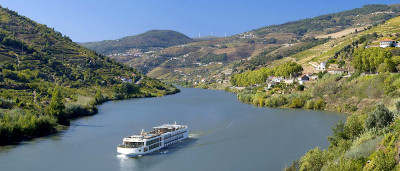
Amsterdam, Budapest, and Prague are some of the most popular river cruise ports, but there are dozens of others including many smaller towns in France where few other tourists will be when you stroll off the ship. There is little or no entertainment on the river cruise ships, but passengers don’t miss it because the entire day and into the evening is spent just steps from local cultural offerings and restaurants.
>>>Check for Europe and river cruise deals
Itinerary 5: France, Belgium, and Netherlands
Paris to Brussels: 1 hour 22 minutes
Brussels to Bruge: 58 minutes
Bruges to Amsterdam: 2 hours 45 minutes
Amsterdam to Paris: 3 hours 17 minutes
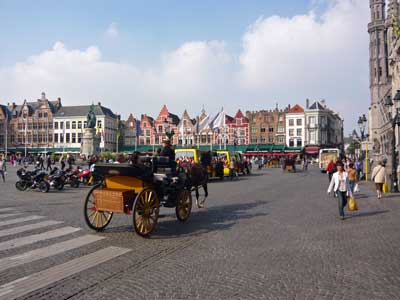
Spending 4 nights in Paris and 3 nights in Amsterdam would be a great trip, but if you want to see something else you’ve got a couple options in between. My advice is to spend an afternoon looking around the Grand Place (main square) in Brussels and then hop a 58-minute train ride to Bruges for a night or two. Brussels isn’t a great tourist city, but Bruges really is so it’s a better option for most people. Whatever you choose out of this group, you can be back in Paris on another high-speed train for your flight home.
Best add-ons to France, Belgium, and Netherlands
- Luxembourg City (1 or 2 nights)
- Cologne, Germany (1 or 2 nights)
- London (3 or 4 nights)
- Interlaken, Switzerland (2 or 3 nights)
>>>Check Paris hotel deals
>>>Check Bruges hotel deals
>>>Check Amsterdam hotel deals
Itinerary 6: Paris and elsewhere in France
- Paris (3 or 4 nights)
And a choice of:
- Nice/Cannes/Monaco (2 or 3 nights)
- Avignon (2 nights)
- Bourges (2 nights)
- Bordeaux (2 nights)
- Aix-en-Provence (2 nights)
- Reims (2 nights)
- Dijon/Burgundy (2 nights)
- Normandy (2 nights)

While Nice is a wonderful tourist city for a look at the French Riviera, the other larger cities of Lyon and Marseilles are probably better saved for a future trip because they are light on key sights compared to many smaller towns. Wine lovers can rent a car or take trains into Bordeaux or Burgundy. Since you can get between most of these towns by train in 2 hours or less, spending only 2 nights in each one is a reasonable option if you want to see a lot in a short time.
Normandy is an interesting choice and easy to reach in only about two hours by train from Paris. Some visitors like to see the famous WWII beaches and memorials, while others (especially in summer) like to check out one or more of the beach-resort towns. Deauville is one of the more famous of those, and it’s also famous for its horse race track and as one of the epicenters of the industry in Europe.
Best add-ons to Paris and elsewhere
- More France, of course
- London (3 or 4 nights)
- Interlaken, Switzerland (2 or 3 nights)
- Amsterdam (2 or 3 nights)
>>>Check Paris hotel deals
>>>Check Nice hotel deals
Itinerary 7: Italy
Rome to Florence: 1 hour 16 minutes
Florence to Venice: 1 hour 53 minutes
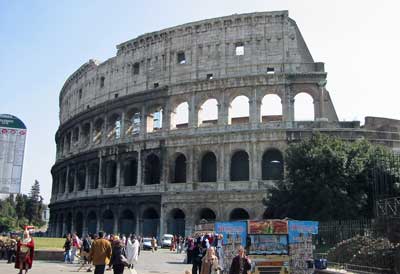
Venice is small enough that you can see the main sights in about 24 hours, and it’s so insanely crowded that many people tire of it after about a day as well. It’s better to pay more for a hotel to be on the main island and visit quickly than to save money with a hotel on the mainland where you’ll be in crowds going back and forth as well. Florence is the most relaxing of the 3, and also a great base for side trips to Pisa, Siena, and Cinque Terre, just to name a few.
Going to Italy? Here are the best first-time Italy itineraries for 3 days to 2 weeks (in much greater detail)
Best add-ons to Italy
- Milan (1 or 2 nights)
- Lake Como (2 nights)
- Siena (2 nights)
- Cinque Terre (1 night)
- Naples/Sorrento/Amalfi Coast/Pompeii/Capri (3 to 5 nights)
- Sicily (3 to 4 nights)
>>>Check Rome hotel deals
>>>Check Florence hotel deals
>>>Check Venice hotel deals
Itinerary 8: Spain
Madrid to Barcelona: 2 hours 30 minutes
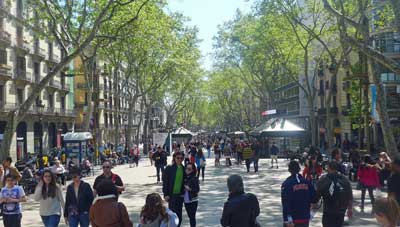
A huge part of Spain’s tourism industry is built around its southern beaches and islands such as Ibiza, Mallorca, and Tenerife (in the Canary Islands). For most people it’s best to ignore those places on your first trip because none of the beaches are special enough to spend days on them compared to the culture of the cities.
Best add-ons to Spain
By popular demand, I’ve added a full article on where to go in Spain with itineraries from 7 to 10 days up to two weeks.
>>>Check Madrid hotel deals
>>>Check Barcelona hotel deals
>>>Check Lisbon hotel deals
Itinerary 9: Germany
Berlin to Munich: 6 hours 2 minutes
Munich to Rothenburg ob der Tauber: 2 hours 56 minutes
Munich to Füssen: 2 hours 4 minutes
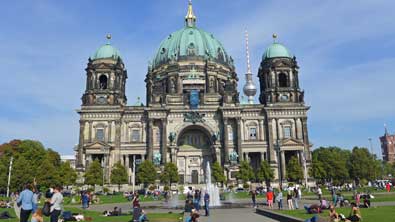
Those two cities are the keys to a Germany visit, and after that you’ve got a wide variety of choices. I cover most of the popular choices in my article on where to go in Germany, which covers several smaller towns that are major highlights.
Best add-ons to Germany
- Cologne (1 or 2 nights)
- Hamburg (2 or 3 nights)
- Amsterdam (3 nights)
- Prague (3 nights)
- Salzburg (2 or 3 nights)
- Vienna (3 nights)
- Interlaken, Switzerland (3 nights)
- Lucerne, Switzerland (2 or 3 nights)
>>>Check Berlin hotel deals
>>>Check Munich hotel deals
Itinerary 10: Switzerland
- Interlaken (3 nights)
- Bern (1 night)
- Lucerne (3 nights)
Zurich Airport to Interlaken: 2 hours 10 minutes
Interlaken to Bern: 53 minutes
Bern to Lucerne: 1 hour 50 minutes
Lucerne to Zurich Airport: 1 hour 3 minutes
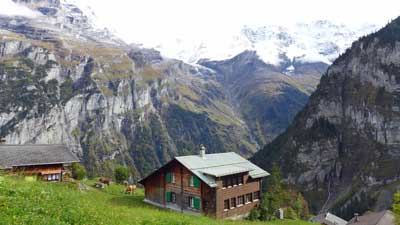
Interlaken is the best hub for the most dramatic Alps views and experiences. The one-hour cable car ride up to the Schilthorn observation deck is something you’ll never forget, and the only thing that might be more dramatic is the train ride up to the Jungfraujoch station, which is the highest in Europe. Lucerne is almost as beautiful with a scenic lake at its heart and also great mountaintop views nearby. If you do want to see a Swiss city then the capital of Bern is the most interesting and photogenic on a short visit. Read more about where to go in Switzerland for even more ideas.
Best add-ons to Switzerland
>>>Check Interlaken hotel deals
>>>Check Lucerne hotel deals
Itinerary 11: Eastern Europe’s best cheap cities
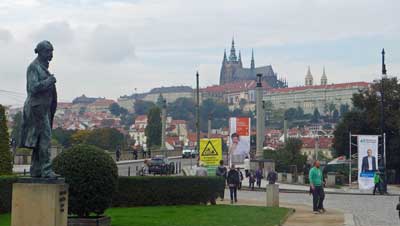
Each of these cities is beautiful and historic, but English is less widely spoken so they can also be quite a bit more challenging for a first-time visitor. Another difficulty is that the trains between them are still quite slow compared to the high-speed rail in the West, so it takes most of a day from one to another, and a bus is often a better choice. I cover this best cheap Europe itinerary more fully in the linked article.
Prague to Budapest: 6 hours 41 minutes
Budapest to Krakow: 9 hours 54 minutes (flying might be better)
Best add-ons to cheap Eastern Europe
- Cesky Krumlov, Czechia (2 nights)
- Ljubljana, Slovenia (2 or 3 nights)
- Split, Croatia (3 nights)
- Belgrade, Serbia (2 or 3 nights)
- Sarajevo, Bosnia and Herzegovina (2 or 3 nights)
- Sofia, Bulgaria (2 or 3 nights)
>>>Check Prague hotel deals
>>>Check Budapest hotel deals
>>>Check Krakow hotel deals


Hi Roger, thank you so much for the article. I’m heading to Europe for the first time for 16 days, minus 2 for flight there and back, so 14 total. I’m really considering Paris and Amsterdam, but I’m not sure what else I should see. I’m thinking Paris -> Amsterdam -> Berlin -> back to Canada. I’m not very experienced with multi-city travelling so I hope you could help with some input. I’d like to keep everything Schengen as I need a visa, however.
David,
With 14 days in Europe I would suggest at least 3 or 4 cities and perhaps even 5 as long as they are easy to reach from one another. On the other hand, if you are fascinated by Paris and Amsterdam and really love the idea of spending a week in each, it could be a great trip because both are large and fascinating cities. But most people on a first trip to Europe like to cover as much ground as possible, and most people try to move too quickly. My advice is to spend 3 or perhaps 4 nights in each city you visit because that allows you time to see all of your top interests and still move fast enough to see quite a few places. For most people, the 4th or 5th day in one city means doing things that were way down your list when you got there.
Paris and Amsterdam are both excellent choices and only a bit over 3 hours apart by train. Berlin is another great choice and only a bit over 6 hours from Amsterdam by train. Prague is another wonderful option that many people do after Berlin, as it’s only a bit over 4 hours by train. Or you could stay closer to Amsterdam and also spend a couple days in Bruges with a short stop in Brussels. Another option is Munich, which is only about 4 hours from Berlin by high-speed train, and of course all of those are in the Schengen Zone.
That should give you some good choices. Let me know if you have any other questions. -Roger
Hi Roger,
Thank you so much for your earlier advice. We will be in Paris for 4 days and Amsterdam for 3 nights this June. This is our first trip to Europe. We will be traveling with two kids, 9 and 5 years old. We do want to enjoy our time in Amsterdam but we were wondering if we would be able to do a trip to Geithborne without losing out on the sights in Amsterdam. Would we end up losing out on Amsterdam sights because of the Geithborne trip or is that something we should do another time. And would you be tell us the best way to get to Geithborne from Amsterdam in case we do make the trip. Thank you again.
Shefali,
I assume you are referring to Giethoorn. I’m not really familiar with it, but it appears to be about two hours from Amsterdam by train and bus. It looks like an interesting place, though at two hours each way (and that’s from the train station) it’s going to take up most of a whole day. You could see 3 or 4 major attractions in Amsterdam in that same time, and Amsterdam is packed with fascinating sights, so I’m not sure it’s worth missing so much for a day trip like that. And the kids might not be too happy with the long trip there and back either. Still, if Giethoorn is a place you’ve always wanted to see then it might be the highlight of the trip. It’s hard for me to say one way or another. It looks like you have to take 2 or 3 short train rides starting from Amsterdam Centraal and then a bus ride to finally reach Giethoorn. Best of luck with whatever you decide. -Roger
Hi,
i am travelling to Madrid next week for business for four days. i will be travelling solo. i am a female and would particularly need advise on accommodation that is reasonable( private) like 60 euros max. need your advise and tips on it.
after reading through your answers i am tempted to form an itinerary and need your kind review.
4 nights MADRID – 3 nights BARCELONA. HIGH SPPED TRAIN
BARCELONA- 3 nights PARIS (NIGHT TRAIN OR CHEAP FLIGHT???)
PARIS TO 3 nights INTER LAKEN (TRAIN)
further shall i inlude 2 nights Germany , Munich) or Vienna, Austria or Prague Czech and fly out to Pakistan. Do you think 4000 euros will suffice.
Looking forward to your kind advise
Teena,
Your plan looks quite good and well thought out. I’d take the train from Barcelona to Paris as long as it’s in the same price range or lower because it’s much more pleasant than flying. There’s a 18:30 departure that gets into Paris at 07:00 the next morning. I’m not a big fan of night trains, but that one looks pretty good. The day trains take only about 6.5 hours and don’t require a change.
I think your budget should be enough, although I don’t know what a flight to Pakistan costs. As for finding cheaper hotels the best advice I can give you is to check booking.com, as they seem to have the best deals in Europe. Personally, I prefer a smaller and more basic room in a central neighborhood to a larger and more luxurious room on the outskirts, partly because you save a lot of time not having to go back and forth. Just look for hotels with a large number of positive reviews that are in a neighborhood you like and you should be okay. Europe has many small hotel rooms meant for exactly one person and they are often very cheap. I think Munich, Vienna, or Prague would all be great choices for a final stop, and it might matter most how cheap your flight to Pakistan is from each of them. Let me know if you have any other questions. -Roger
Roger, I am so excited that I stumbled upon your website. I am reading some of the questions and answers you provided. The summer of 2019 will be one of travel and celebration as I will be graduating from college at the youthful age of 64. I have 3-4 weeks off to travel. I have a friend in Northern Ireland to visit with either on the way over or back and a family member to visit in Sweden and also Slovenia. Along with those specifics I would like to visit Rome, Aix en Provence, Auschwitz, Prague and many other places. I am asking for suggestions for timeline for train purchases etc. i.e. when should I have this itinerary completed in order to be on time with reservations. I would appreciate any suggestions and caveats with my thoughts of where I would like to travel to! Much thanks, Carol Haggerty
Carol,
That sounds like a wonderful trip and it’s never too soon to start planning if you enjoy the process. As I say so frequently, I strongly recommend 3 nights in just about any place you visit, so the number of places you can stop will be determined by how many total days you have available. Northern Ireland, Sweden, and Slovenia are all obviously very spread apart so you’ll have to fly between all of them and that doesn’t make it any easier. Auschwitz is a fascinating day trip near Krakow, and Krakow itself is very worthwhile for a couple days.
The challenge I’m seeing with your current plans is that almost none of the places you want to visit are within reasonable train distance from each other. You can fly all over Europe, but it’s much less enjoyable to spend every third day in airports and on planes, as opposed to on trains. So my first suggestion would be to lock in the places you definitely want to visit and then try to find other places to add that are within 400 kilometers or so. Hopefully you can string at least 3 or 4 of those together before you have to fly to another corner of Europe.
As long as you buy your train tickets at least a month or two in advance you should be getting the cheapest fares, but for flights it’s best to book 3 or more months in advance if you can. I’m happy to help you as you get your itinerary together so feel free to ask more questions. -Roger
Thank you so much for all this amazing info !!! We are planning our first trip to Europe next summer as a graduation gift to my daughter . I’ve been going back and forth on whether to do a tour or do it ourselves . We want a stress free itinerary !!!! I love your suggestions for itineraries! We will be flying to London and then we aren’t sure ? Will be there 10-14 days . Any new suggestions regarding itineraries would be appreciated !! Thanks again !
Cheryl,
I’d definitely do it yourself rather than as a tour. Even though it feels daunting and intimidating to plan something like this yourself for the first time, Europe is actually extremely easy to get around on your own. Also, as a tour you’d be lumped with 10 to 40 other people (the cheaper tours have more people on them) and you can only ever go as fast as the slowest person on the tour.
I think the best first-time itinerary would be London for 3 days and then the Eurostar train for 3 days and then a flight to Venice for a day or two and then a train to Florence for 3 days and a train to Rome for 3 days. That itinerary is pure highlights and contains much of the best of Europe. Think about that as a starting idea and I will be happy to help you change it if you have other preferences or ideas. -Roger
Hi Roger, this is an amazing thing you’re doing here. I was hoping you could help me decide on a few things about my trip, I’m from South Africa and I’m planning on going to Europe for my first trip. I’m thinking Lagos Madrid Ibiza Barcelona Amsterdam Berlin Budapes. Please assist me in in deciding if I should leave any out, how long I should I stay. And where I should fly or use the train. I’m 20. Years old and looking to party a little bit more than touring but a little bit of everything including shopping. Your assistance is immensely appreciated.
Mo,
I’m glad you find this helpful. All of those cities on your list are worth visiting if you have the time and money. My strong recommendation is to spend 3 days in nearly any place you visit, and that includes all of the ones on your list. One challenge will be that Amsterdam to Berlin is the only one that can be reached easily by train, although you can take a train from Madrid to Barcelona and then a flight from Barcelona to Ibiza and from there to Amsterdam.
The party scene in all of those places is excellent, although in Ibiza is really only runs from June through mid September and then it starts getting quiet again. The rest are great all year round. If you are going alone I think I would stick to the bigger cities and save Ibiza for another time. It’s almost all big groups of people who come to party together, and there isn’t much of a scene for solo travelers. I’d suggest Madrid to Barcelona to Paris to Amsterdam to Berlin to Prague, which you could all do by train. I’m happy to answer any other questions if you have them. -Roger
Thank you so much. Are there carriers you could recommend for economical flights?
Carrie,
As for going across the Atlantic I would choose the cheapest flight on any airline that has flight times that look good to you. All airlines that fly across the Atlantic have fairly good legroom and service. Once in Europe you’ll have more choices of low-cost carriers. Ryanair is based in Ireland and they are my least favorite because the seats are small and they have so many extra fees. EasyJet is one of their main competitors and I like them quite a bit more so I’m willing to pay a bit more to fly them. But you will have other options that should be similar. So I’d avoid Ryanair and take the next cheapest one that has good departure times. -Roger
Roger, your site is amazing and inspiring. My 22yoa daughter and I want to do a first time 2week trip to Europe in late Sept. She’s listed Ireland, London, Paris, Amsterdam and Switzerland or Belgium as her preferred destinations. She really doesn’t want to let go of Ireland… I’ve read thru your suggestions for cities and amounts of time in each loci but my questions are what would be the best way to include Ireland? Where is the best place to fly into from the US? Which airline do you recommend and between which countries for the most economical result? I think we’ll need to narrow to 4 locis if Ireland is included. Thoughts? And thank you so much for your generous advice.
Carrie,
If you want to include Ireland it’s probably best to do it first. You could fly into Shannon Airport, which is close to many of the best small towns and sights, or Dublin Airport. It would probably be cheapest to book a round trip from your home into Ireland and then fly from Ireland to your other destinations on European low cost carriers.
As I’ve mentioned before, Dublin is an interesting city, but I feel that the best of Ireland is the smaller towns and castles and natural sights. So you could spend maybe 2 days in Dublin and then 2 or 3 days in Galway or elsewhere to get a feel of the real Ireland. Then fly to London for 3 nights. You can then take the Eurostar train to Paris for 3 nights and then a train to Amsterdam for 3 nights before flying back to Ireland and then home. That would be the best version of what you have discussed that I can recommend. Buy all of those plane and train tickets as soon as possible for the lowest fares. Let me know if you have any other questions. -Roger
Hi Roger
My husband and i are interested in a two week approx honeymoon in europe. Amsterdam is a must for us. What other places would you suggest we travel to revolving around an Amsterdam visit?
Thanks in advance 🙂
Maddie,
Amsterdam is amazing and you will love it there. I even lived there for a few months at one point. The best and most obvious places to combine with Amsterdam are Paris (a bit over 3 hours by train) and also London (a bit over 2 hours on the Eurostar train from Paris). You could also go to Berlin, which is about 6 hours away by train, and Prague isn’t too far from Berlin.
Closer to Amsterdam you can also consider Bruges and Brussels, or even Cologne or Luxembourg City. In two weeks I would plan on 4 or maybe 5 total cities at most, so it’s a matter of which of those appeal to you most. Let me know if you have any other questions. -Roger
Roger,
We have someone we would like to visit in Germany, end of July/early August 2019. We have never left the US before, and want to try and utilize the 2 weeks as best possible. We would really like to try and do Ireland and Italy. Any suggestions would be greatly appreciated. Since I will be 50 and it will be my first trip out of the country, I doubt I will get back any time soon. Gotta get the most out of this trip!
Terri,
Germany, Ireland, and Italy are an unusual combination for one trip, mainly because they share no borders. If you have two weeks I would focus on 5 cities that you want to visit, rather than countries. The shortest Italy trip that I recommend is one night in Venice, three nights in Florence, and three nights in Rome. That is an action-packed week filled with highlights.
If your friend lives near an airport in Germany you could fly in from Rome and then fly to Ireland. As for Ireland, I think a week there is also a good place to start. Dublin is an interesting city, but it’s really the small towns and castles and natural sights that are what make Ireland so special. So think about which places are your highest priority and I will be happy to help you plan if you have more questions. -Roger